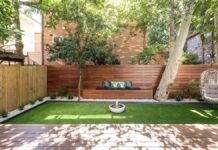Over time, homes tend to gather objects that can make living areas feel claustrophobic and cluttered. Statistics suggest that the average American home has over 300,000 things that haven’t been sorted out.
Whether it’s emotional ornaments from travels, gifts from loved ones, or day-to-day stuff, our spaces inevitably diminish as our collections expand.
Plus, if you live in Bennington, where the average house size is smaller compared to neighboring areas, you might find yourself grappling with the challenge of limited space.
Recent data indicates that the average house size in Vermont is 1,815 square feet, making it a struggle for many to find extra space for their belongings.
But what if there was a way to recapture that lost space and breathe freely in your own house again? Homeowners can truly improve their living spaces by utilizing inventive and imaginative solutions.
In the following journey, we’ll look at various techniques for unlocking the hidden potential of every corner and making the most of the area you call home.
1. Rent a Storage Unit
In recent years, Vermont has seen a surge in tiny dwellings, reflecting a growing trend for downsizing and simplifying living arrangements. With the increasing popularity of these small homes, the necessity for additional storage has become critical.
Residents in Bennington, Vermont, where the typical dwelling size is significantly less than in more urban regions, have increased their demand for versatile storage solutions.
We suggest using Bennington storage units to store things you need and tidy your living space while it’s renovated. This way, your stuff will be secure, and you can access it anytime without worrying about damaging anything.
2. Vertical Space
Think vertical, not just horizontal! Vertical storage is a smart strategy for maximizing space, especially in rooms with limited square footage. You can transform unused areas into practical storage solutions by utilizing wall height. Some ideas for vertical spaces includes:
- Wall-Mounted Shelves: These are perhaps the most common vertical storage solutions. From floating shelves that add a touch of modernism to your room to bracketed ones that can handle heavier items, they’re versatile and can be placed almost anywhere.
They’re perfect for books, photo frames, plants, and kitchen supplies.
- Pegboards: Once limited to workshops and garages, pegboards have made their way indoors, providing a customizable canvas for hanging tools, craft supplies, kitchen utensils, and even jewelry.
They can be painted to match room colors, making them functional and decorative.
- Magnetic Strips: Especially popular in kitchens, these are excellent for knives, spice jars with magnetic lids, and other tools. They’re sleek, require minimal space, and keep essentials within arm’s reach.
- Wall Hooks and Vertical Racks: Sometimes, simple hooks are all you need. They can be used in bedrooms for accessories, bathrooms for towels, or entryways for coats and bags.
Vertical racks, on the other hand, can be used for items like shoes or even magazines.
3. Declutter Regularly
Sometimes, having fewer things is the best way to create more space. Regular decluttering can transform a crowded home into a breathable and organized sanctuary.
By periodically assessing the items in your home and determining their relevance and utility, you can decide what truly adds value to your space and what merely takes up room.
Moreover, by donating or recycling items we no longer need, we can give them a second life and reduce waste. This opens up physical space and promotes mental clarity by reducing visual and mental clutter.
4. Mirror Magic
While mirrors don’t technically create more physical space, they make rooms feel larger and more open. This optical illusion is achieved as mirrors reflect light, brightening a room and providing an impression of extended space.
When placed opposite windows, mirrors can maximize the natural light inflow, enhancing a room’s airy ambiance. Similarly, mirrors can visually double the space, making it feel less confined when used in narrow hallways or small rooms.
Furthermore, using mirrors on furniture pieces or as decorative wall elements can multiply their spatial effects. For instance, mirrored coffee tables or cabinets give the impression of less cluttered floor space.
5. Storage Under the Bed
Under-bed storage is a practical and efficient way to utilize wasted space in bedrooms. While traditional bed frames leave limited room beneath, many modern designs now incorporate built-in drawers.
It is ideal for storing linens, seasonal clothes, or even shoes.
For those without integrated storage, there’s a variety of standalone rolling bins or flat storage containers specifically designed to fit snugly under most beds. These containers can help maintain organization, keep dust away, and easily access belongings.
6. Multi-purpose Furniture
Multi-purpose furniture has emerged as a game-changer, especially in urban settings where space is at a premium. These ingenious pieces combine two or more functions, optimizing space and utility.
A prime example is the sofa bed. By day, it provides comfortable seating in a living room; by night, it effortlessly transforms into a bed for guests.
In children’s rooms, bunk beds with integrated desks or drawers effectively utilize vertical space, providing sleep, study, and storage solutions.
7. Retractable Items
Retractable items are designed to maximize space by folding or rolling back into a compact form when not in use. These items are perfect for homes with limited space or those aiming for a minimalist aesthetic.
Examples include retractable clotheslines, which allow homeowners to dry clothes naturally and then fold the line back when done, or retractable kitchen racks for drying dishes.
Retractable tables and desks can provide working space when needed and be discreetly tucked away.
The beauty of these items is their dual functionality: they serve their primary purpose efficiently, and once their task is done, they effortlessly blend into the home’s design or disappear altogether, ensuring living areas remain spacious and uncluttered.
Conclusion
Incorporating even a few innovative solutions can drastically change how your home feels. With imagination and planning, you can maximize every inch of your living space, making it functional, organized, and comfortable.







































